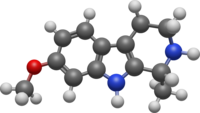Tetrahydroharmine
 |
|
 |
|
| Names | |
|---|---|
|
IUPAC name
(1R)-7-Methoxy-1-methyl-2,3,4,9-tetrahydro-1H-pyrido[3,4-b]indole
|
|
|
Systematic IUPAC name
7-Methoxy-1-methyl-2,3,4,9-tetrahydro-1H-β-carboline
|
|
| Other names
1,2,3,4-Tetrahydroharmine; Leptaflorine; 2,3,4,9-Tetrahydro-7-methoxy-1-methyl-1H-pyrido(3,4-b)indole
|
|
| Identifiers | |
|
17019-01-1 |
|
| 3D model (Jmol) | Interactive image |
| 3DMet | B02865 |
| Abbreviations | THH |
| ChEBI |
CHEBI:311931 |
| ChEMBL |
ChEMBL129208 |
| ChemSpider |
140510 |
| KEGG |
C09243 |
| MeSH | Tetrahydroharmine |
| PubChem | 159809 |
|
|
|
|
| Properties | |
| C13H16N2O | |
| Molar mass | 216.28 g·mol−1 |
| Basicity (pKb) | 10.334 |
| Pharmacology | |
| Legal status |
|
| Hazards | |
| Flash point | 195.2 °C (383.4 °F; 468.3 K) |
|
Except where otherwise noted, data are given for materials in their standard state (at 25 °C [77 °F], 100 kPa).
|
|
| Infobox references | |
Tetrahydroharmine (THH) is a fluorescent indole alkaloid that occurs in the tropical liana species Banisteriopsis caapi. THH weakly inhibits serotonin reuptake.
Two other harmala alkaloids in B. caapi, harmaline and harmine, are reversible inhibitors of monoamine oxidase A. Tetrahydroharmine, however, does not inhibit monoamine oxidase B.
Harmala alkaloids are considered Schedule 9 prohibited substances under the Poisons Standard (October 2015). A Schedule 9 substance is a substance which may be abused or misused, the manufacture, possession, sale or use of which should be prohibited by law except when required for medical or scientific research, or for analytical, teaching or training purposes with approval of Commonwealth and/or State or Territory Health Authorities.
...
Wikipedia
